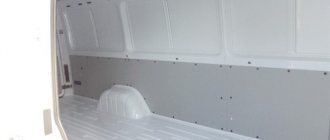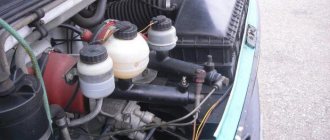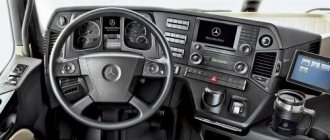Mercedes Sprinter Classic is a small truck that is owned by. Widely known in the commercial environment, it has proven itself well both as a van for transporting goods and as a minibus transporting people. In the transport business it is famous as one of the most reliable cars.
Mercedes Sprinter is focused on the successful work of its owners. Wide functionality, efficiency, high performance and safety are not all the advantages that are acquired with the purchase of this car.
Mercedes Sprinter 1st and 2nd generation: details about gasoline and diesel consumption
Among utility vehicles, the Mercedes Sprinter, produced since 1995, is extremely popular. This is one of the most common commercial vehicles in the world, with universal technical and operational characteristics that make its use extremely profitable. The main advantage is the fuel consumption rate of all modifications of the Mercedes Sprinter, one of the most economical in its class. The car has other advantages:
- high reliability of all components;
- minimal repair costs;
- high load capacity for its size;
- adapted suspension;
- several options for passenger and cargo bodies with a carrying capacity of up to 4.6 tons;
- ergonomic cabin, adapted for long-distance transportation.
Two generations of this car were presented, the first was produced from 1995 to 2006, the second is still in production. In addition, the model has undergone several restylings in order to improve its appearance and technical characteristics.
Similar models
But, it’s worth paying tribute to the power unit, with good constant maintenance and the elimination of minor faults, it runs for quite a long time, from 300 thousand kilometers or more. The most popular vehicles for transporting goods and passengers are the Sprinter Classic family of vehicles, the production of which started back in 1995, including the Mercedes Sprinter Classic 311 passenger van, almost a minibus, and a regular cargo van.
Features of mentality
According to the official version, the first 300 assembled cars were disposed of, smashed in crash tests, distributed to dealerships and body manufacturing companies without the right to sell, and simply disassembled for spare parts. The basic equipment of the Sprinter Classic includes many practical and convenient features, such as a two-seater front passenger seat and remote-controlled central locking.
Price new and used
The price of a car depends on the configuration in which it is provided, as well as on the country of origin. If we take, for example, a version of a van assembled in Russia, then the standard price starts from 1 million 170 thousand rubles. The “Corporate Bus” package, which is the top package today, costs from 1 million 590 thousand rubles. Options for bodies designed for transporting passengers - from 1 million 450 thousand rubles.
The following options are popular for our car market:
- vans, wheelbase 3550/4025mm – cost from 1 million 220 thousand rubles;
- minibus taxis, seats 17+1, stock equipment - from 1 million 458 thousand rubles;
- minibus taxis, seats 20+1 – from 1 million 544 thousand rubles.
Used versions are priced depending on the year of manufacture. For a 2014-15 car, the price starts from 1 million 300 thousand rubles. And, accordingly, the earlier a car is produced, the cheaper it is. Models 2008-09 can be purchased from 700 thousand rubles.
It is noted that cars in a cargo body are more practical and multifunctional than passenger cars. Passenger vehicles are characterized by a special mode of use, often as a minibus, so their acceleration and braking time increases significantly. Vans are characterized by a more gentle mode of use.
General malfunctions of 2.1 CDI engines. First pancake
The interaction of a diesel engine and a six-speed manual or automatic transmission guarantees high technical performance and ease of control. The Mercedes-Benz Sprinter Classic can cope with any task, whether as a van for transporting goods or as a minibus for transporting passengers.
| Engine capacity | Power | Transmission | Drive unit | Fuel | Consumption |
| 2.1 l | 163 hp | Automatic transmission | rear wheel drive (FR) | Diesel fuel | 6,5 |
| 2.1 l | 129 hp | Automatic transmission | rear wheel drive (FR) | Diesel fuel | 6,6 |
| 2.1 l | 129 hp | Manual transmission | rear wheel drive (FR) | Diesel fuel | 6,9 |
| 2.1 l | 163 hp | Manual transmission | rear wheel drive (FR) | Diesel fuel | 6,9 |
| 2.1 l | 163 hp | Automatic transmission | rear wheel drive (FR) | Diesel fuel | 6,9 |
| 2.1 l | 129 hp | Automatic transmission | rear wheel drive (FR) | Diesel fuel | 7,0 |
| 2.1 l | 163 hp | Manual transmission | rear wheel drive (FR) | Diesel fuel | 7,2 |
| 2.1 l | 129 hp | Manual transmission | rear wheel drive (FR) | Diesel fuel | 7,2 |
| 2.1 l | 163 hp | Manual transmission | four-wheel drive (4WD) | Diesel fuel | 7,7 |
| 2.1 l | 129 hp | Manual transmission | four-wheel drive (4WD) | Diesel fuel | 8,0 |
| 3.0 l | 190 hp | Automatic transmission | rear wheel drive (FR) | Diesel fuel | 8,3 |
| 2.1 l | 129 hp | Automatic transmission | four-wheel drive (4WD) | Diesel fuel | 8,5 |
| 2.1 l | 163 hp | Manual transmission | four-wheel drive (4WD) | Diesel fuel | 8,7 |
| 2.1 l | 163 hp | Automatic transmission | four-wheel drive (4WD) | Diesel fuel | 8,7 |
| 2.1 l | 129 hp | Manual transmission | four-wheel drive (4WD) | Diesel fuel | 9,1 |
| 3.0 l | 190 hp | Manual transmission | rear wheel drive (FR) | Diesel fuel | 9,3 |
| 3.0 l | 190 hp | Automatic transmission | four-wheel drive (4WD) | Diesel fuel | 9,5 |
| 3.0 l | 190 hp | Manual transmission | four-wheel drive (4WD) | Diesel fuel | 9,5 |
| 1.8 l | 156 hp | Automatic transmission | rear wheel drive (FR) | Gasoline AI-95 | 11,4 |
| 1.8 l | 156 hp | Automatic transmission | rear wheel drive (FR) | Gas/petrol | 11,5 |
| 1.8 l | 156 hp | Manual transmission | rear wheel drive (FR) | Gasoline AI-95 | 12,2 |
| 1.8 l | 156 hp | Manual transmission | rear wheel drive (FR) | Gas/petrol | 12,6 |
Technical characteristics and dimensions
The main technical characteristics of the Mercedes Sprinter 311 include:
| speed | 158 km/h; |
| number of seats in the cabin | 3; |
| lifting capacity | 1.44 t; |
| weight | 2.07 t; |
| total weight | 3.5 t; |
| drive unit | 4x2 or 4x4; |
| wheelbase | 3.55 m; |
| turning radius | 12.8 m; |
| clearance | 0.15 m. |
The dimensions of the car are 5.64 m x 1.74 m x 1.92 m. The luggage compartment is 3.27 m long.
Return to content
Mercedes Benz Sprinter engines and official consumption rates Features and benefits
| Consumption of Mercedes Sprinter diesel - Blog of a car lover A powerful, durable engine and a well-thought-out safety concept are as convincing as maximum performance and guaranteed maintenance. I didn’t like it much; it’s a rather weak engine for Crimean roads, up and down constantly, the engine power is not enough on inclines, especially if the interior is full. |
| Technical characteristics of Mercedes-Benz Sprinter 311 cargo. (Mercedes Sprinter 2. 1 CDI): performance characteristics, parameters and description One of the largest auto companies in the world even in some way blessed the concept bearing a three-pointed star for further life and development, which made the CW 311 the only vehicle with the Mercedes emblem that was not developed by the Stuttgart people and, nevertheless, was authorized for operation. In 2007, a new generation of the Mercedes Sprinter minibus was offered with an exceptionally successful 906 body and an updated line of gasoline and diesel engines with improved dynamics and reduced fuel consumption. |
- on busy streets 9.9 l;
- on average 8 l;
- on a freeway 6.9 liters.
What's the price?
Depending on the modification, the availability of additional options and equipment, the cost of the model is determined. Standard assembly costs about 1.66 million rubles. when installing a van-type superstructure, and 1.67 million rubles. – minibus.
When buying a used car, it is worth remembering that the technical condition of cargo versions will be better than passenger ones. This is due to the fact that the latter type of car is often used in urban transportation (minibus taxis), therefore, the wear of the brake system and other units and components will be much higher. When buying a used car, you need to pay attention to the condition of all systems and mechanisms, as well as corrosion.
The price of a Mercedes Benz Sprinter 311 produced in 14/15 is 1.3-1.7 million rubles, in 08/09 – 700-850 thousand rubles.
Return to content
Mercedes Sprinter real fuel consumption per 100 km: reviews
- Vitaly, Orsk, 79 l. With. I have a Sprinter purely for work, they provided me with the 1997 version, with 79 hp. diesel. In the end, I am satisfied with the machine; it is a practical workhorse, with an energy-intensive chassis and a large load capacity. I have an all-metal van, used primarily in urban environments. Average fuel consumption is 11 liters per hundred kilometers. Thanks to the high torque period, it is possible to easily accelerate to 100 km/h.
- Ilya, Samara, 2.9 122 l. With. The Sprinter is the optimal light commercial vehicle. I say this as a driver with 20 years of experience who has had the opportunity to drive a Gazelle, Iveco, Volkswagen and other vans. The sprinter consumes 11-13 liters of diesel fuel, it is an excellent and thorough car.
- Elizaveta, Novosibirsk region, 2.3 79 l. With. I am satisfied with the car, a wonderful multifunctional car for all needs, economical and practical. Impenetrable chassis, acceptable steering feedback, roomy body and low fuel consumption. In the city, 10-12 liters are consumed.
- Alexander, MSK, 2.3 79 l. With. I have owned the Mercedes-Sprinter for seven years, during which time I have covered about 130 thousand kilometers. The car was manufactured in 1999, purchased at the used car market. I work for myself, doing courier deliveries. Approximate fuel consumption is 12 liters per hundred kilometers.
- Igor, Tambov, 2.3 79 l. With. A durable and tenacious car, perfect for the domestic climate, and adequately withstands salty winters. Frisky 79l. With. diesel consumes 10-11 liters per hundred kilometers.
- Renat, Rybinsk, 2.9 122 l. With. The optimal car between opponents. We took a batch of Sprinters on the used market, the distance covered was within 75-150 thousand kilometers. Quite untired options, manufactured in 2001. Good visibility, high-quality interior materials, excellent load capacity and durable chassis, practical diesel engine with an operating capacity of 2.9 liters. Its maximum power is 122 hp. With. enough to spare. According to the previous owners, the power unit performed optimally. Moreover, they recognized this knot as the most thorough. In addition, the engine is quite practical in city mode, and consumes approximately 12-14 hp.
- Arthur, Rybinsk, 2.3 79 l. With. I liked the car; I have a Sprinter van, equipped with a modest and practical 2.3-liter diesel engine. Consumes approximately 13 liters per hundred kilometers.
- Ilya, Kalmykia, 2.9 122 l. With. I liked the car, I use the van every day for 16 hours, transporting construction materials. The car is solid and does not cause any difficulties in terms of construction. Approximate fuel consumption is 11 liters per hundred kilometers. 122l. With. The diesel engine is torquey and reserves maximum power, able to pull even from the bottom, but at high speeds it is no longer a spark. On the highway it comes out to 9 l/100 km.
- Marat, Yakutsk, 2.9 122 l. With. The Sprinter has the most powerful engine, its maximum power is 122 hp. With. Enough with your head. The kinetics feel adequate. In addition, I would like to note its good carrying capacity. When the body is full, the van is still just as dynamic – thanks to the reserve traction and maximum power. All the same, the diesel engine drags and is exemplary for this class of car. In the city and moderate traffic jams 12 liters are used, on the highway 9-12 liters are consumed
- Evgeniy, Tver region, 2.3 79 l. With. diesel. In the end, I was satisfied with the car; I was given the Sprinter package with a 2.3-liter diesel engine with a maximum maximum power of 80 horsepower. There are a lot of difficulties with the power unit; firstly, the diesel fuel freezes too quickly. There is no pre-heater, so there is a need to purchase additives. The car is being repaired in a workshop provided by our transport company. Consumption is around 11-13 l/100 km.
- Roman, Chuvash Republic region, 2.3 79 l. With. My Sprinter has traveled 125 thousand kilometers. The poor parts of the car are a rotting body in the area of the side door sills, the power unit is defective, the clutch is weak, and the manual transmission malfunctions. In short, all these difficulties arose during the warranty period, so we managed to save money. True, the body still rots, and there is a need to treat it with anticorrosive every year. 79l. With. diesel consumes 11 l/100/100 km.
- Vitaly, Krasnoyarsk, 2.3 79 l. With. In the end, I am satisfied with the car, the car is purely for city roads and luxury, by the way, I am a private entrepreneur. The car is equipped with a 2.9-liter. a power unit that consumes an undisturbed 11-13 liters per hundred kilometers.
- Ilya, St. Petersburg, 2.3 79 l. With. Sprinter 2005, more or less a tireless option. I bought it on the secondary market for my own household and family needs. I have a full size minivan equipped with 79hp. diesel. The maximum power is sufficient with reserve, the average consumption is 12-13 liters per hundred kilometers.
Engine • First generation
| Mercedes-Benz Sprinter Classic 311 CDI (A3) Three years later, a restyled version of the Mercedes ML 350 was presented at the Detroit Auto Show, which received significantly increased dimensions, as well as a more daring and sporty appearance. The wide range of vehicle versions available can solve almost all industry issues, from commercial transportation to ambulance service or police. |
| Fuel consumption of Mercedes Sprinter - (diesel and gasoline) per 100 km ABS and ASR systems, reliable brakes, airbag and seat belts are also installed as standard and protect the driver of the Mercedes Benz Sprinter Classic 311 CDI in emergency situations. Difficulties in the normal operation of the Mercedes Benz Sprinter 515 appear when scheduled maintenance is not met and due to difficult working conditions. |
- 2.2, 88 l. With. since 2006
- 2.2, 95 l. With. since 2006
- 2.2, 109 l. pp., since 2006
- 2.2, 129 l. With. since 2008
- 2.2, 150 l. pp., since 2006
- 2.2, 163 l. pp., since 2006
- 2.2, 156 l. pp., since 2006
- 3.0, 184 l. pp., since 2006
- 3.0, 190 l. pp., since 2006
- 3.5, 258 l. pp., since 2006
Fuel consumption • As for the level of comfort, it corresponds to a passenger car.
Driver's cabin
To manufacture the cabin, a stamping method is used, with which solid sheet metal is processed. The cabin has a hood design, and the main components are equipped with reinforcement elements. Safety is ensured by a large viewing angle and larger rear-view mirrors. The interior space of the cabin has a large volume, which ensures the comfort of two passengers and the driver.
Inside the cabin of the Mercedes Benz Sprinter 311, three seats or seven (double-row cabin) can be installed. Finishing materials are of high quality, which ensures their durability and wear resistance. The operator's seat has lumbar support and heating, is covered with fabric, and is equipped with seat belts and headrests.
Being inside the car is just as pleasant as being in a passenger car. The steering wheel can be adjusted in height and tilt. Air conditioning is available as an option.
The interior lining of the Mercedes Benz Sprinter Classic 311 is made of insulating materials, which guarantees driver comfort when transporting people and goods. The cabin is mounted on rubber cushions.
The pedals are installed taking into account the operator's comfort; they do not allow you to feel fatigue and discomfort even during long trips. The cabin has plenty of storage compartments.
Return to content
Mercedes Benz Sprinter engines and official consumption rates
To expand the customer base, the manufacturer offers several powertrain options for this car. Reliable and high-torque diesel engines are more popular. Sprinters equipped with them have reduced fuel consumption, which is a decisive argument for carriers.
The manufacturer offers several options for gasoline engines, characterized by traditional reliability, the ability to operate in any climatic conditions and a long service life. The use of modern technologies has made it possible to significantly reduce their appetite, increasing the profitability of such cars.
Steering and instrument panel
As standard, the Mercedes Benz Sprinter 311 truck is equipped with disc brakes on all wheels and an improved hydraulic braking system with two circuits and an electric lining wear indicator. Brake pads, Drum pads, Pad wear sensor, Pad repair kit, Pad spacer, Rear pads, Handbrake pads, Front pads, Brake linings, Brake discs, Rear brake discs, Front brake discs, Brake drum, Rear brake drum, Drum bearing, Brake hoses, Brake pipes, Brake caliper, Caliper repair kit, Rear caliper, Caliper guides, Front caliper, Caliper piston, Caliper boot, Caliper bracket, Hydraulic accumulator, Vacuum brake booster, ABS, ABS unit, ABS sensor, Vacuum pump, Brake pedal, Switch Brake Light, Air Brakes, Parking Brake, Handbrake Cable, Brake Cylinder, Master Cylinder, Brake Reservoir, Brake Service Cylinder, Rear Brake Cylinder, Front Brake Cylinder, Brake Cylinder Repair Kit.
Second generation - First pancake
Another version of this engine for the Sprinter produces up to 109 horsepower at 208 Nm, accelerating the car to 141 km h, while it has more economical consumption. It is clear that the ergonomics designed many years ago do not correspond to modern realities, but I personally cannot say that everything is a failure; indeed, all that was missing was an additional 12-volt outlet, and I easily came to terms with everything else, especially since that more modern analogues are also full of problems in terms of placing the same bottles or thermos.
| Engine | Consumption (city) | Consumption (highway) | Flow (mixed) | Fuel type |
| 4.0 AT 250 hp (machine) | 14,7 | 8,8 | 10,9 | Diesel |
Analogs
The Mercedes Sprinter doesn't have many analogues. And it’s not surprising, because... Not every car can compete with a car of such high quality.
Ford Transit is often put on the same level as Mercedes. It also has many options for body solutions, and some of their characteristics are the same (gearbox, fuel consumption, etc.). Among the differences is that Mercedes breaks down much less often. And in terms of carrying capacity, the Sprinter is many times superior to the Ford. But in terms of comfort and interior design, Ford has overtaken its competitor. Which one to choose is up to everyone to decide for themselves, but Mercedes is priced higher than Ford.
Another analogue is the Volkswagen Krafter. It is also cheaper than a Mercedes and is less demanding to maintain. The car is practically in no way inferior to its competitor, so both are considered worthy representatives of the Germans.
The Mercedes Sprinter minibus is compared with IVECO daily. But this is a purely subjective opinion of everyone, because... Sprinter's characteristics are significantly higher. But according to driver reviews, many prefer IVECO.
Other services. Features of mentality
| Mercedes sprinter classic 311 cdi technical specifications. Mercedes-Benz Sprinter Classic - review and technical specifications The Mercedes-Benz Sprinter Classic can cope with any task, both as a van for transporting goods and as a minibus for transporting passengers. Mercedes-Benz doesn’t particularly like to actively advertise the variety of bodies it offers from bodybuilders, so we’ll tell you about the most interesting options on the market ourselves. |
| Mercedes Sprinter fuel consumption The first two days of the test drive, I carefully looked for creaks, rustles, rattles or boom-booms from the belly of the car, but well, the concept of Russian assembly and familiarity with experimental cars left their mark. In cars equipped with a particulate filter, it was initially not used at all, in 2003 it appeared in some models, and later it began to be used en masse and when driving only around the city, problems arise with self-regeneration, and the oil is also diluted by fuel. |
- city 12.3 l;
- mixed cycle 9.9 l;
- on the highway 8.5 liters.
Story
The car was prepared for release over three years, from 1992. The samples were subjected to rigorous selection and testing at German, French and Spanish testing grounds. The concern spent all its material and intangible resources (experience, strength) on them.
First generation
Production of the model began in 1995. The prototype was the T1 light-duty vehicle, which gained popularity back in the 80s. However, Sprinter overtook its predecessor in terms of success. The new generation was released in 9 standard configurations, running on diesel, gasoline, and gas units.
In the end, the efforts paid off. The first generation of light-duty trucks had a mass of 2600-4600 kg, engines with a power of 80-160 hp. and load capacity 7500-3500 kg. The scope of their application was varied: household farming, transportation of construction materials, transportation of people with an increased level of comfort.
Manufacturers completely abandoned the dependent suspension, improved handling performance, reducing the turning radius by as much as 15%. In addition, many more innovations were introduced:
- the leaf spring suspension has been completely redesigned;
- the suspension life was increased by 2 times due to the use of a transverse spring at the front and longitudinal springs of variable thickness at the rear;
- refusal of the steering gearbox, in return - a steering rack and power steering wheel;
- Noise is reduced due to silent blocks to the beam;
- refusal of rubber-metal couplings in gearboxes;
- The front suspension is fundamentally new: the kingpins are replaced by shock absorber struts with ball joints (the rear suspension is a modernized version of the T1 suspension).
The elements were chosen so well that the developers did not abandon them even in the new version. After only a year of production of the first generation, the car received the “Van of the Year” award. Almost half a million copies were produced in the first years of production for the European market. This was a powerful bid for success.
The first significant modernization took place in 2000. Old diesel engines were replaced with environmentally friendly ones of 2.1 and 2.7 liters. This replacement was also due to the greater efficiency of the unit. Gasoline engines were modernized together with the transmission. An ESP system was also introduced into the equipment.
In 2001, sales of the car began in the Japanese and North American markets. In the USA the model was known as the Freightliner Sprinter, the Japanese called them the Mercedes-Benz Transporter T1N.
In 2003, the Germans entered into an agreement with the American company Dodge, merged the concerns and began joint production under the name Dodge Sprinter.
Second generation
The second modification was presented to the public in 2006. The cars had 6 body options: van, versions with sides (two and four doors), minibuses.
A fundamentally new solution was three types of wheel base. The changes also affected the exterior. The radiator grille began to be made of chrome-plated steel, and the air intakes increased in volume. In general, the car received more masculine features.
In addition, the cars were equipped with a stability control system, hydraulic booster, and electric windows.
The engine was increased in volume to 3.5 liters and a power of 285 hp. Transmission – five-speed automatic. Drive – rear.











